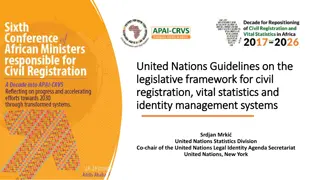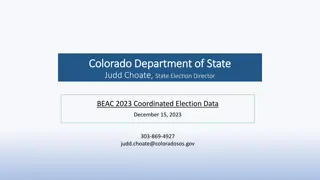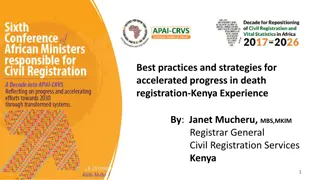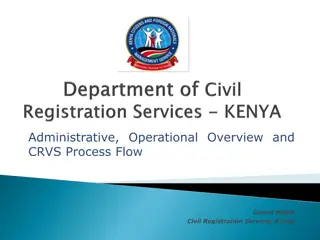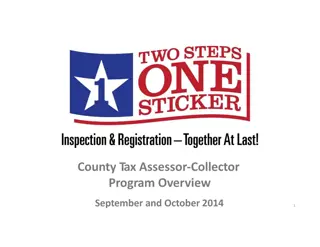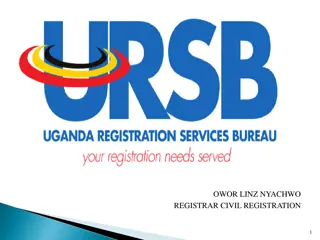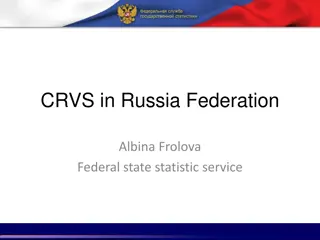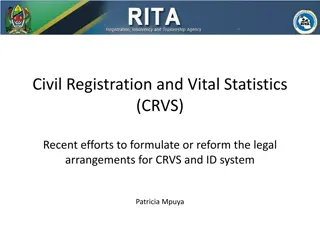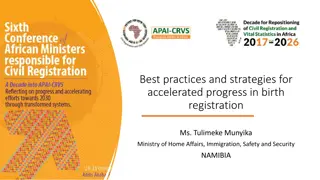Comprehensive Overview of Civil Registration System in India
Civil registration system in India, governed by the Registration of Births and Deaths Act, 1969, plays a crucial role in recording vital events such as births and deaths. This system ensures universal, continuous, compulsory, and permanent registration, providing reliable statistics for evidence-based planning and governance. The system's multi-faceted implications on socio-economic development make it a key component of governance in the country.
Download Presentation

Please find below an Image/Link to download the presentation.
The content on the website is provided AS IS for your information and personal use only. It may not be sold, licensed, or shared on other websites without obtaining consent from the author.If you encounter any issues during the download, it is possible that the publisher has removed the file from their server.
You are allowed to download the files provided on this website for personal or commercial use, subject to the condition that they are used lawfully. All files are the property of their respective owners.
The content on the website is provided AS IS for your information and personal use only. It may not be sold, licensed, or shared on other websites without obtaining consent from the author.
E N D
Presentation Transcript
The Global Summit on CRVS Civil Registration System and Sample Registration System R. K. Gautam Director Office of the Registrar General, India
Sub- Topics History of Civil Registration System & Vital Statistics in India The Registration of Births & Deaths Act, 1969 (RBD Act, 1969) Salient features of the RBD Act, 1969 Roles and Responsibilities of registration functionaries Forms under the system of registration of births and deaths
Sub- Topics Sources of data for generating Vital Statistics Process of compilation of Vital Statistics Process of Dissemination of Vital Statistics Level of Registration
Introduction to Civil Registration System Civil Registration System popularly known as birth and death registration system is the recording of vital events i.e. live births, still births and deaths under the statutory provisions on a continuous and permanent basis. The registration records are documents and secondarily as a source of statistics. useful primarily as legal In India, the system of civil registration has been in operation for more than a century. At present the registration of births and deaths is being done under Registration of Birth and Death Act,1969.
CIVIL REGISTRATION SYSTEM National Vital Statistics including Registration of Births and Deaths at Sl. No. 30 falls under Concurrent List of the Constitution of India. Mandatory under RBD Act 1969
Civil Registration System Comprehensive and complete CRS has multi-faceted implications on socio-economic development of a country. A complete & up to date CRS can provide: Reliable Statistics on fertility & mortality at all level of aggregations Almost on a real time basis which is not possible from any sample survey. Key for evidence based planning and has no parallels The levels of registration reflects the quality of governance.
Civil Registration System The essential features of Civil Registration System are: Universality Continuity Compulsory Permanence
Civil Registration System CRS has the following components: Law Civil Registration Structure People Participation Services to Public Checks and Balances
Civil Registration System (CRS)- Scenario Registration of Births and Deaths in India is mandatory with the enactment of Registration of Births and Death Act (RBD Act), 1969. Registration of Births and Deaths falls under the Concurrent list of the Constitution. Registrar General, India unifies and coordinates the activities of the States. States are responsible for implementation of RBD Act. National Population Policy mandates cent percent registration.
Registration of Births and Deaths Act, 1969 Uniform law across the country for the registration of births and deaths Reporting and registration of all births and deaths compulsory Responsibilityto report the event For Domiciliary births ------head of households For Institutional events --- in charge of the institution
Appointment of Notifiers Free registration of births/deaths Delayed Registration of events Penalties on the persons/ establishments Issue of certified extracts from the birth or death register Registration of birth without name
HISTORICAL BACKGROUND Mid of 19th Century Registration of deaths with a view to introducing sanitary reforms for control of pestilence and diseases Indian Famine Commission, 1880 Central Births, Deaths and Marriages Registration Act, 1886 Conference on Improvement of Vital Statistics 1961 recommendation
RBD Act 1969 Bill received assent of the President on May 31, 1969. Notified in the Gazette of India Extraordinary, Part II Section I, on June 2, 1969. Enforced on April 1, 1970. Model Rules 1970. A new set of Model Rules under the revamped system Jan 1, 2000.
Salient features of the RBD Act, 1969 Uniform law across the country on the registration of births and deaths. Reporting and registration of all births and deaths compulsory. Registrar General, India to co-ordinate and unify the implementation of the Act. Provision of birth registration - without the name of the child. Name can be entered later but not after 15 years from the date of registration.
Salient features of the RBD Act, 1969 contd Penalties for non-reporting/non-registration of the events. Issue of extract Birth / Death certificate. Correction or cancellation of entries Issue of free certificate of birth/death in case the registration is done within 21 days. Provision for delayed registration.
Registration Hierarchy Registrar General, India Coordinates and unifies the implementation of the Act in the country Chief Registrar Chief Executive authority in the State/Ut for implementing the provisions of the Act District Registrar Supervision of the registration of births and deaths in the District Registration of births and deaths and submission of statistical Information on registered births and deaths Registrar
Registration Hierarchy National level: Registrar General, India Joint Registrar General Assistant Registrar General for the States State level: Chief Registrar Additional Chief Registrar/Deputy Chief Registrar District level District Registrar Additional District Registrar Local level Registrar of Births & Deaths Sub-Registrar for specified areas within the area under the jurisdiction of a Registrar.
Revamping of the Civil Registration System The process of registration has been revamped To reduce the paper work To speed up the tabulation of CRS data. The procedures for registration of births and deaths have been modified to some extent and the forms redesigned. Most of the tables in the tabulation plan are prepared based on the information of place of usual residence of mother in case of births and place of usual residence of deaths in case of deaths.
Revamping of the Civil Registration System Salient features of the revamped system are: revision in the content and size of the registration forms, redesigning of forms by segregating the legal items from the statistical items, addition of new relevant items viz. birth weight, duration of pregnancy, age of mother at the time of marriage; and deletion of the Notifier forms, etc. Consequently, the number of forms was reduced from 21 to 13.
Forms used under the revamped system of registration of births and deaths Form No. 1: Form No. 1A: Birth Report for Adopted Child; Form No. 2: Death Report Form; Form No. 3: Still Birth Report Form; Form No. 4: For Medical Certification of Cause of Death (for Hospital Patients); Form No. 4A: For Medical Certification of Cause of Death (for Non-Institutional Deaths); Form No. 5: Birth Certificate; Birth Report Form;
Forms used under the revamped system contd.. Form No. 6: Form No. 7: Form No. 8: Form No. 9: Form No. 10: Non Availability Certificate; Form No. 11: Summary Monthly Report of Births; Form No. 12: Summary Monthly Report of Deaths; Form No. 13: Summary Monthly Report of Still Births. Death Certificate; Birth Register; Death Register; Still Birth Register;
Statistical Reporting System Monthly Statements on registered births and deaths Registrar Consolidated monthly returns on registered births and deaths for the district District Registrar Annual Statistical Report Annual Report on working of the Act Chief Registrar State Govt. Annual Statistical Report -Vital Statistics of India Registrar General, India Annual Report on working of the Act Govt. of India
Sources of data on Vital Statistics in India In India, the vital statistics are mainly generated through: Population Census- Decadal Process Civil Registration System Sample Registration System (a demographic survey)
Population Census The population census is the most comprehensive source of basic demographic characteristics providing data on size, structure and growth of population even for smaller administrative areas. It is a decadal operations. Hence, does not provide information on growth of population and related demographic variables on yearly basis. 24
Process of Compilation & Dissemination of Vital Statistics CRS: On the basis of returns/reports received from States, annual report on Vital Statistics of India based on CRS are being released. SRS: On the basis of data received from SRS sample units, Annual Statistical Report based on Sample Registration System are being released.
Civil registration systems are considered to be complete if they cover 90% or more of all live births and deaths. In India, the coverage of registration system is incomplete and not up to the mark to be utilized for statistical purposes at the National level. However, there are 21 and 14 States/UTs where the coverage of birth and death registration respectively is more than 90%.
Performance Indicator (Level of Registration) The level of registration (LOR), defined as the percentage of registered births/deaths to the births/deaths estimated through SRS, determines the performance level of a State /Union Territory in respect of registration of births and deaths.
Registration Scenario in India during last 5 years LOR (Birth) India: 69.0% to 83.6 % ( + 14.6 %) LOR (Death) India: 63.2% to 67.4% ( + 4.2%) 15 States/UTs have achieved 100% registration of births. 7 States/UTs have achieved 100% registration of deaths. Some of the major States remains the main concern.
Still about every 5th birth & every 3rd death goes un-registered.
Medical Certification of Causes of Death (MCCD) Introduced in early 1970s to provide cause-specific mortality profile. Restricted to urban areas, that too few selected hospitals. At various stages of implementation across different States. Coding is as per ICD-10. Covers about 20% of the total registered deaths only. Garbage codes(R00-R99) are to the tune of 12.5%.
Time Series on Medically Certified Deaths vis-a-vis Total Registered Deaths Reported for the Period 1986-2010 6000 Number of Deaths (in thousand) 5000 Total Registered Deaths 4000 3000 Registered Deaths Not Medically Certified 2000 1000 Medically Certified Deaths 0 1986 1987 1988 1989 1990 1991 1992 1993 1994 1995 1996 1997 1998 1999 2000 2001 2002 2003 2004 2005 2006 2007 2008 2009 2010 ORGI has expanded the scope under MCCD to all Institutions including individual practitioners and the coverage , extended to rural areas as well.
Evaluation : Despite having statutory provisions, registration data are deficient due to incomplete coverage and under-registration. Extent of incomplete coverage and under- registration varies from State to State.
Why SRS is implemented ? The increasing acuteness of the population problem and the deficiencies in the statutory Civil Registration System, intensified the need for quick and reliable estimates of birth and death rates on current and continuous basis.
Sample Registration System Genesis Initiated in 1969-70 for want of complete registration from CRS. Objectives Provide reliable annual estimates of birth, death and infant mortality rates at the State and National levels separately for rural and urban areas. Also provides Child Mortality Rate (CMR), Total Fertility Rate (TFR), Sex Ratio at Birth and 0-4 age, Institutional deliveries, Medical Attention before death, etc. Under 5 mortality rate also generated from 2008 annually. Features One of the largest demographic household sample survey in the world Sample size determination based on IMR Permissible level of RSE: 10% (bigger states) 1.3 million households and about 7 million population Only panel survey with dual recording Panel revised once in 10 years based on the latest available Census frame
Sample Registration System (SRS) SRS organised by the Office of the Registrar General, India in 1964-65 on a pilot basis and became operational on full scale from 1969-70. One of the largest demographic sample of household survey covering 1.3 million households and about 7 million population in the new SRS (based on 2001 census frame).
SRS is a dual recording system with the main objective of providing reliable annual estimates of birth and death rates at the State and National levels. SRS also provides estimates of Infant Mortality Rate (IMR), Under Five Mortality Rate (U5MR) and Total Fertility Rate (TFR).
Main components of SRS Baseline survey of sample units. Continuous enumerations of vital events namely births and deaths. Half-yearly survey. Matching of events enumeration and supervisor. Field verification of unmatched and partially match events. collected by
The field investigation under SRS consists of a continuous enumeration of births and deaths by an enumerator (preferably teacher) and an independent retrospective survey by a full-time supervisor. an anganwadi/local six-monthly The data obtained by the two methods are matched. The partly matched and unmatched events are re- verified in the field to get an unduplicated count of events.
Revision of SRS Sample Frame The revision of SRS sampling frame is undertaken every ten years based on the results of latest census. While changing the sample, modifications in the sampling design; wider representation of population; overcoming the limitations in the existing scheme; meeting requirements etc. are taken into account. the additional The first replacement was carried out in 1977-78 and the last being in 2004. The revision of SRS sample based on 2011 Census frame has been done.
Revision of SRS Sample Frame Based on the recommendations of the Technical Advisory Committee(TAC) on SRS, the sample units have been increased from 7597 in 2004 to 8861 units for 2014. New SRS frame will be effective from 1.1.2014. baseline survey is expected to start in January, 2014. At present ground segmentation work is under process. identification and
Replacement SRS sample units 1969-70 1977-78 1983-85 1993-95 2004 2014 Rural 2432 3684 4176 4436 4433 4967 Urban 1290 1738 1846 2235 3164 3894 Total 3722 5422 6022 6671 7597 8861
Sample design of current SRS The sample design adopted for SRS is uni-stage stratified simple random sampling without replacement, except for larger villages. For larger villages with population 2000 or more, two stage stratified sampling has been adopted . The final level of stratification for all strata is Female literacy. Rural stratification:- Each major state is geographically divided into NSS Natural division. There are 2 to 6 natural divisions in a state formed by grouping contiguous administrative districts with distinct geographical and other natural characteristics. Within each Natural division, villages are grouped into two strata based on size class. Stratum I: population less than 2000 Stratum II: population 2000 or more
For villages with population less than 2000 (stratum-I), the entire village has been selected. Villages having population 2000 and above were segmented in such a way that the population within each segment was more or less of equal size not exceeding 2000 each. All the segments were shown on the village map and one was randomly selected.
Urban stratification Uni-stage stratified simple random sampling has been adopted with 2001 census urban enumeration blocks as the sampling units. The cities/towns have been stratified in 4 Strata as per following criteria: Stratum I: Less than one lakh Stratum 2: 1-5 lakh Stratum 3: 5 lakh and above Stratum 4: Four metro cities, Delhi, Mumbai, Chennai and Kolkata as separate strata. ( proportional allocation to slum population)
A simple random sampling of enumeration block is selected without replacement from each of the size classes of towns/cities in each State/UT. The following statement shows the number of sample units selected in 2004 separately for rural and urban areas for all States/Uts.
Information collected under SRS Births: a. Particulars of the child: Place of birth, date of birth, live birth/still birth, single/multiple birth, sex etc. Particulars of the mother: a. Mother s relation to head, residential status, present age, religion, type of medical attention received at delivery etc. 46
Deaths: Particulars of the deceased: Place of death, date of death, relationship to head, Residential status, sex, age at death, marital status, religion, Medical attention before death. 47
Estimation Procedure The estimation of population, live births, deaths and infant deaths are obtained using unbiased method of estimation. Estimates of birth rate, death rate and infant mortality rates are obtained as the ratio of estimated births to estimated population, estimated deaths to estimated population and estimated infant deaths to estimated births, respectively. 48
Publications SRS-Bulletin : Annual publication giving annual vital rates at all- India and State/Ut levels. SRS Statistical Report: detailed the tables giving fertility and mortality indicators are published in this annual publication. 49
Other Publications SRS based Abridged life Table Baseline Survey Report Special Bulletin on Maternal Mortality in India Report on Causes of Death in India 50



